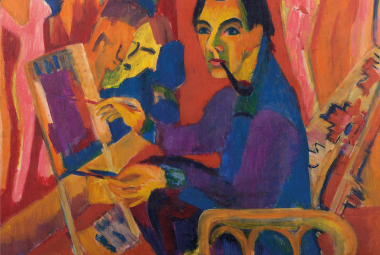Jan Altink
Groningen 1885 - Groningen 1971
Founder of De Ploeg in 1918
In 1900 Jan Altink was enrolled at the Minerva Academy as a student at the evening course. During his training he won many prizes and medals. In 1911 he obtained his degree for drawing teacher. He earned his income by teaching evening classes and as a decorative painter. In May 1918 he was one of the founders of the De Ploeg for which he had also invented the name. Between 1925 and 1932 he made advertising work for Vroom and Dreesmann in Zwolle and Meppel. In 1933 he was a member of the committee for the anniversary exhibition of De Ploeg at Fongers in Groningen.

Outdoor painting
Characteristic for Jan Altink's work is his love for working outside, alone but also with Job Hansen and Ekke Kleima. He was an accurate draftsman and left an important oeuvre as a graphic artist. In 1922 his use of colour became brighter; in 1923 he exhibited graphic work for the first time. In 1924 there is a breakthrough in his work; in this year he produced his first expressionist paintings, in wax paint and with strong bright colours. The years between 1924 and 1927 are considered Altink's most important. In those years he exhibited about eighty paintings. In the period 1928-1941 the emphasis shifted from oil paint to tempera and watercolour. He also made many drawings during this period. When he moved to a neighbourhood in the south of the city of Groningen in 1933, he shifted his attention to painting and drawing the landscape of the north of Drenthe.

Expressionism
On the occasion of his 75th birthday in 1960, the Groninger Museum organized the first retrospective exhibition of his work. D.H. Couvée, director of the Frans Halsmuseum in Haarlem in 1978, associates the renewed interest in Jan Altink’s work at the time to the general rediscovery of pre-war expressionism. Altink’s expressionism was at its strongest in the 1920s, especially in depicting the Groningen landscape with unmixed colours and surfaces without shadows. It has been said that if one comes from elsewhere, one has to get used to the Groningen countryside. However, as a ‘Groninger’, Altink has a natural feeling for this elementary landscape. The viewers of his work can experience Altink’s love for the Groningen countryside through the joy in colour, light and space that his work radiates. Apart from the Groningen landscapes, his portrait of Hendrik Werkman from 1925 belongs to his masterpieces.
After the war Altink continued to work with various media and techniques. After his retirement, he traveled and worked mainly in the southern France.
Literature
Text: Toos Boersema
Cees Hofsteenge, De Ploeg 1918-1941, De Hoogtijdagen. Groningen: Benjamin & Partners 1993. Adriaan Venema, De Ploeg, 1918-1930, Baarn: Het Wereldvenster 1978. D.H.Couvée,’ Jan Altink en het expressionisme’ in: D.H. Couvée, W. J. de Guyter, Jan Altink, 21 october 1885- 6 december 1971, Jan Altink Stichting, Heemskerk 1978, 53-58. W. Jos de Gruyter ‘Jan Altink’ in: D.H. Couvée, W. Jos de Gruyter, Jan Altink, 21 october 1885- 6 december 1971, Jan Altink Stichting, Heemskerk 1978, 60-96.
